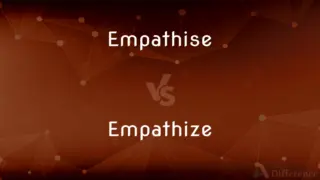Pacify vs. Placate — What's the Difference?
By Tayyaba Rehman & Fiza Rafique — Updated on March 25, 2024
Pacify involves calming someone down or making peace, often through conciliatory actions or addressing the root cause of unrest. Placate is specifically about appeasing or pacifying someone through concessions or soothing gestures, focusing on discontent.

Difference Between Pacify and Placate
Table of Contents
ADVERTISEMENT
Key Differences
Pacify and placate are both verbs that deal with the act of reducing anger, agitation, or rebellion, but they operate at slightly different levels of engagement and intent. On the other hand, placate is about soothing someone's anger or displeasure, usually through specific actions or words designed to appease them.
In essence, while pacifying might involve a range of strategies from dialogue to systemic changes aiming for long-term peace, placating is more about immediate, often superficial, measures to ease discontent. Pacifying can require a deeper understanding and more sustained effort, whereas placating might rely on quick fixes or temporary measures.
Despite these nuances, in everyday language, the terms are sometimes used interchangeably due to their overlapping meanings in the context of reducing anger or unrest. However, understanding their distinctions can clarify the intent and depth of the actions taken to resolve conflicts.
Comparison Chart
Definition
To bring peace to, calm down, or quell unrest.
To appease or pacify someone by making concessions.
Focus
Addressing underlying issues for long-term peace.
Immediate alleviation of anger or discontent.
ADVERTISEMENT
Strategy
May involve comprehensive solutions.
Often involves temporary measures or concessions.
Intent
Aiming for lasting resolution or calm.
Focused on quick relief from negative feelings.
Context
Used in broader scenarios, including social or political unrest.
Often used in personal or diplomatic situations requiring quick fixes.
Compare with Definitions
Pacify
Can imply addressing root causes of conflict.
The new policy was designed to pacify longstanding community grievances.
Placate
Does not necessarily address deeper issues.
The measures were only enough to placate them temporarily.
Pacify
To calm someone down or make peace.
The government introduced social reforms to pacify the protesters.
Placate
Focuses on soothing displeasure or discontent.
The company placated the critics with a public apology.
Pacify
Implies a more lasting peace or calm.
Through negotiation, they sought to pacify the volatile situation.
Placate
Used in situations requiring quick fixes.
To placate the crowd, the organizer promised a rescheduled event.
Pacify
Involving a reduction of anger or agitation.
The manager's calm demeanor helped to pacify the angry customer.
Placate
Often involves temporary or superficial measures.
Gifts were given to placate the upset partners.
Pacify
Often used in contexts of conflict resolution.
Diplomats worked tirelessly to pacify the warring factions.
Placate
To appease someone's anger with concessions.
He offered a refund to placate the dissatisfied client.
Pacify
Quell the anger, agitation, or excitement of
He had to pacify angry spectators
Placate
Make (someone) less angry or hostile
They attempted to placate the students with promises
Pacify
To ease the anger or agitation of (a person or the mind, for example).
Placate
To allay the anger of, especially by making concessions; appease.
Pacify
To calm or soothe (a feeling, such as anger).
Placate
(transitive) To calm; to bring peace to; to influence someone who was furious to the point that they become content or at least no longer irate.
Pacify
To end war, fighting, or violence in (a region or country), especially by military force.
Placate
Same as Placard, 4 & 5.
Pacify
To subdue or quell (an insurrection or conflict, for example).
Placate
To appease; to pacify; to concilate.
Pacify
To cause (a group) to end a rebellion or other violent action.
Placate
Cause to be more favorably inclined; gain the good will of;
She managed to mollify the angry customer
Pacify
(transitive) To bring peace to (a place or situation), by ending war, fighting, violence, anger or agitation.
Pacify
(transitive) To appease (someone).
Pacify
To make to be at peace; to appease; to calm; to still; to quiet; to allay the agitation, excitement, or resentment of; to tranquillize; as, to pacify a man when angry; to pacify pride, appetite, or importunity.
To pacify and settle those countries.
Pacify
Cause to be more favorably inclined; gain the good will of;
She managed to mollify the angry customer
Pacify
Fight violence and try to establish peace in (a location);
The U.N. troops are working to pacify Bosnia
Common Curiosities
Are pacifying actions always successful?
Not always. The success of pacifying actions depends on the willingness of the parties involved to come to a resolution and the effectiveness of the solutions provided.
Can placating lead to pacification?
Yes, placating can be a step towards pacification, especially if it helps create a calmer environment conducive to addressing deeper issues.
How do you placate someone?
Placating someone involves using actions or words to soothe their anger or displeasure, often by making concessions or offering something to temporarily ease the situation.
Is it better to pacify or placate?
It depends on the context. Pacifying is generally more comprehensive and aims for lasting peace, while placating can be effective for immediate, short-term relief.
Why might someone prefer placation over pacification?
In situations requiring an immediate reduction of tension or anger, placation can offer a quick, albeit temporary, solution, especially when time or resources for a deeper resolution are limited.
What are the risks of placating in conflict resolution?
Placating without addressing underlying issues can lead to temporary relief but might not resolve the conflict, possibly leading to future unrest.
What does it mean to pacify someone?
Pacifying someone means to calm their anger or agitation, potentially by resolving underlying issues that caused the unrest.
Can you placate someone without making concessions?
Typically, placating involves some form of concession or appeasement, but it might also be achieved through reassurances or other soothing measures that don't necessarily concede to demands.
How can organizations effectively pacify discontent?
Organizations can effectively pacify discontent by actively listening to grievances, addressing root causes, and implementing fair and sustainable solutions.
How does culture impact pacifying or placating strategies?
Cultural understandings of respect, authority, and conflict resolution can significantly influence what strategies are considered appropriate or effective for pacifying or placating individuals or groups.
Share Your Discovery

Previous Comparison
Geometric vs. Geometrical
Next Comparison
Empathise vs. EmpathizeAuthor Spotlight
Written by
Tayyaba RehmanTayyaba Rehman is a distinguished writer, currently serving as a primary contributor to askdifference.com. As a researcher in semantics and etymology, Tayyaba's passion for the complexity of languages and their distinctions has found a perfect home on the platform. Tayyaba delves into the intricacies of language, distinguishing between commonly confused words and phrases, thereby providing clarity for readers worldwide.
Co-written by
Fiza RafiqueFiza Rafique is a skilled content writer at AskDifference.com, where she meticulously refines and enhances written pieces. Drawing from her vast editorial expertise, Fiza ensures clarity, accuracy, and precision in every article. Passionate about language, she continually seeks to elevate the quality of content for readers worldwide.












































